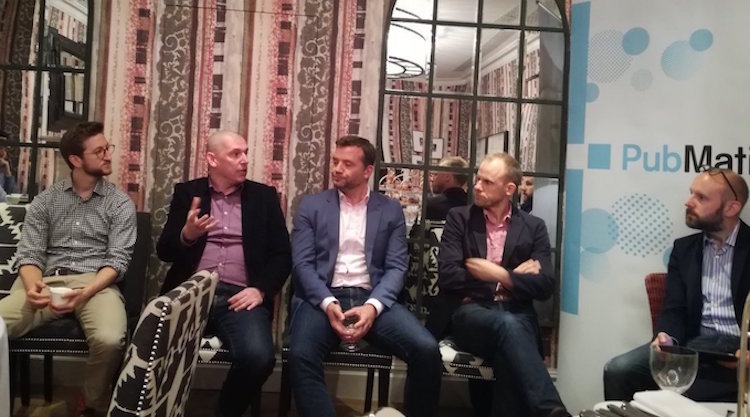It comes as no surprise that transparency has become one of the most pressing issues facing the ad tech industry today. In the past year, the issue has gained prominence across the world with the ANA’s report on media rebates in the US, the overcharging scandal at Dentsu Japan and P&G global brand officer Marc Pritchard’s warning to the “murky” and “fraudulent” digital media supply chain.
As a leader in ad tech with a focus on providing clarity to the market, PubMatic held our own transparency debate at an executive roundtable in the UK last month. We invited 30 key stakeholders from across the publishing and media buying industry to share their views and concerns. Moderated by Jon Mew, CEO of the IAB UK, our panel of industry experts discussed some of the challenges they were facing and also shared their insights and suggestions for best practices that would help the industry achieve transparency.
Our panelists were:
- Daniel Wilkinson, Head of Paid Media, Jellyfish
- Piers North, Group Digital Director, Trinity Mirror
- Dan Larden, Global Strategic Partnerships Director, Infectious Media
- Nigel Gwilliam, Head of Media and Emerging Tech, IPA

THE IMPORTANCE OF REGULATION
Positive change is only valuable if it is enforced, so the panel discussion kicked off with Mew asking the panelists how we can ensure transparency is implemented and regulated throughout the digital sector. There were some points raised about the need for third-party verification and auditors to ensure all members of the supply chain are compliant and companies are not effectively marking their own homework. The walled gardens of Google and Facebook still aren’t as transparent in their analytics and data as many publishers and advertisers want and expect.
This lack of transparency has led to premium advertisers such as Procter & Gamble threatening to curb digital ad spend if platforms refuse to provide more verifiable metrics. Gwilliam followed up by asking, “When it comes to auditors and intermediaries, who watches the watchmen?” Most of the third-party verification companies are for-profit entities and some are even owned by global marketing conglomerates. For an auditor to be truly independent, there was the opinion that it should take the form of an industry body.
THE NEED FOR EDUCATION
The next important point raised was the need for more education in the industry on how we can drive transparency and, in particular, how publishers and advertisers can hold their media partners accountable. Wilkinson stated that we need to “educate both sides rather than just throwing a viewability standard at them.” It’s easy to place the onus upon marketers since it involves their advertising budget, but that allows others to shirk responsibility. It is the responsibility of the industry as a collective because transparency affects us all. If marketers don’t know where their money is going, then reduced brand spend will flow through programmatic channels, resulting in less money to fuel our ecosystem.
A true partnership is based on mutual trust, and it all begins with education. Initiatives such as PubMatic’s PubAcademy, a series of education seminars designed to inform both publishers and buyers on the latest research and marketing trends affecting the industry, is one channel to drive this education but it requires a collective effort across the industry to really affect change.
TRANSPARENCY THROUGH CONSOLIDATION
During the discussion, North suggested that perhaps the consolidation of ad tech companies will create increased transparency because there will be fewer organisations to regulate. The current ad tech Lumascape screams out that the economics of so many ad tech and mar tech players is unsustainable, so consolidation seems inevitable. In 2016 alone, there were 412 mergers and acquisitions in global ad- and mar-tech, according to advisory group Results International. Already this year, we’ve seen several big acquisitions, such as the Singtel/Amobee deal with Turn, Salesforce buying Krux, and Oracle purchasing viewability metrics provider Moat.
As point solutions are absorbed, some of the complexity of the ecosystem will fade away. Publishers won’t need to stitch together a confusing array of solutions and will instead have the option of using one platform, such as PubMatic’s omni-channel full stack offering, SEVEN, to plan campaigns, execute sales, serve ads and track performance. The result will not only be simplicity, but more importantly, less friction and greater efficiency. Ultimately, the platforms that will be successful in the future need to ensure that they are open and transparent.
VALUE FROM ATTRIBUTION
Larden concluded the debate by stating that as long as advertisers have the right attribution models in place, digital will work much better for them. More advertisers are relying on third-party data than ever before, demanding greater insight into attribution and cross-channel/device measurement to understand campaign success. Attribution, data access and openness are fundamental in today’s landscape. This is why both the buy and sell sides are investing more in data collection and analytics. To understand ROI and modify campaigns in real-time, they are eager to have access to more pipes and data sources. Technology partners need to offer their clients access to insights at a granular level. Doing so creates a feedback loop that enables greater transparency, while ensuring that campaigns are more effective from the start.
Programmatic ad tech has quickly become the backbone of internet advertising. According to the 2016 IAB / PwC Digital Adspend Report, by 2019 up to 90 percent of all UK digital advertising will be bought programmatically. Automated auctions and workflows allow for smarter, more efficient data-driven transactions. However, even with its considerable benefits, many continue to cite transparency challenges across programmatic environments. With programmatic technology so deeply embedded in the ad supply chain, solutions providers need to ensure they are educating their customers and being upfront about demand sources, fees, CPMs, viewability and attribution.





